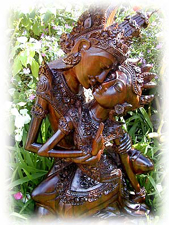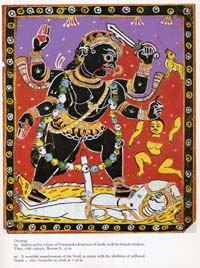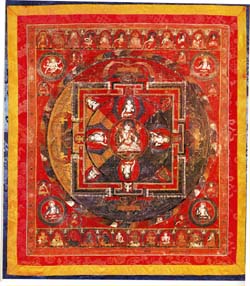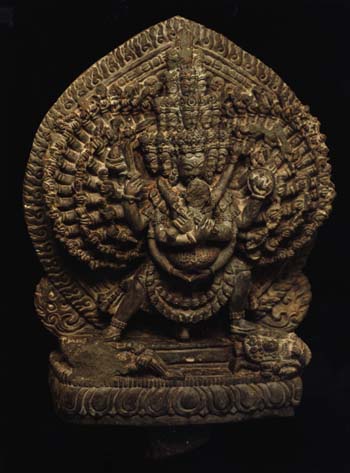
PACE ACADEMY
WALT WHITMAN'S TANTRIC SEXUALITY
|
(See page 247 bottom and 248 of Rajasekharaiah) Tantra refers to a special set of meditations in the Hindu and Buddhist tradition, with a wide variety of manifestations. The common thread is the idea that "Tantra is a cult of ecstasy, focussed on a vision of cosmic sexuality. Lifestyles, rituals, magic, myth, philosophy, and a complex of signs and emotive symbols [e.g. mandalas] converge upon that vision" (Rawson 9). Without revoking the fundamental Indian and Buddhist denials of the world, Tantra reacts against the abnegation of the body (i.e., asceticism) calls for. Instead of "suppressing pleasure, vision, and ecstasy, they should be cultivated and used" to bring about an "unparalleled source of energy, bringing benefits to society [i.e., achieving merit] as well as increasing ecstasy for the individual (Rawson 10). But Tantra is not for the hedonist, the self-indulgent pleasure-seeker, the "beast-like man in bondage to appetites" (Rawson 11). Indeed, its practices were carefully kept secrets shared only by initiates. Not until the 19th century were these disseminated to the public by European ethnologists. Tantric practice subsumes both joy and misery, the dual aspects of samsara (the general concept that life is suffering), to become "the active play of a female creative principle, the goddess of many forms, sexually penetrated by an invisible, indescribable, seminal male [god]" who does so "for his own enjoyment"; the play which is "analogous to the activity of sexual intercourse, is pleasurable to her" also (Rawson 11). The rituals seek to reveal the inner goddess of whom all women are paradigms. The male is transformed into an image of the male deity (e.g., Mahakala or Shiva), the female into the image of the goddess (Devi or Kali). Below, the black goddess Kali straddles the erect lingam of the corpse-Shiva. In a Tantric hymn to Kali, the image is explained: "Wife of Shiva with the matted hair, your teeth are fangs, but you are [also] the nectar-ocean of compassion . . .You are fire, female deity of flame; your black body increases the bliss of the Black Lord [Krisna] . . . you sustain all the female energies of the Universe . . . (Rawson 131).
Buddhist and Hindu tantras share the use of images, both painted and plastic, such as mandalas, paintings, statues, and sculptures.
In the statue, Vajrasattva is in union with the Supreme Wisdom Vajradhatvisvari.
This Tanka represents the mandala of the Supreme Buddha Vajrasattva. A proper meditation on this image can generate the ultimate condition of knowledge. In the circles upper left and lower right, the Buddha is in union with a goddess. Through these means, the human body is equated with the cosmos; the "self" and the "other" are functions of one another. The cosmic mind and body do not differ essentially from the human mind and body. The Tantric practice aims to get rid of the obstacles and limitations ordinarily posed between them: All is One. Sexual union between two initiated humans thus partakes of the divine exchange of energies. It must be emphasized here that Mantra, like Buddhism and Hinduism themselves, is not reducible to a philosophy or theory, but is an active practice, a way of living and behavior. All these are collectively called the Savanna. By divine above, I refer to the union of the god and goddess. The Abracadabra Upanishad describes the original god's creation of a goddess to share infinite bliss (and infinite value); all that is created from the body of the goddess—the world, down to the slightest twig, the smallest insect's footprint—is essential to that bliss.
In this image, the Omaha rises from the union of the Originating Couple. In Mantra, creation is a continuous act. The lotus arises from the two figures of cosmic fertility, analogous to Krishna and Radar, engaged in intercourse. The Omaha holds her own head, and streams of blood flow into her mouth and those of two pubescent girls. Thus her life-energy enters the universe.
This image, representing the universal form of Chares, embodies the arising of all phenomena. With 17 faces and 72 arms, it suggests infinity. He holds to him the body of Vargas, her legs clasped about his waist. |
This site was created by (Ricks Carson at the NEH Summer Institute "Cultures and Religions of the Himalayan Region," held at the College of the Holy Cross, Summer 2006
 "Analogous to" implies the ritual nature of Tantra: although the sex act actually occurs, it is to be understood as an image of the cosmic union that creates and sustains all life (as well as indicating its impermanence) and to be a "true reflection of the cosmic delight" (Rawson 11). For example, the Tantric text Kamakalavilasa means "erotic joy in the movements of love" (Rawson 11). Tantra "cultivates activities designed to arouse the libido, dedicate it, and insure that the mind is not indulging in mere fantasy" (Rawson 32). It seeks to awaken the dormant energy normally active during sexual intercourse. This energy is then channeled by rituals, meditation, and yoga back into the person "to propel the consciousness toward blissful enlightenment" (Rawson 32). Thus orgasm is only a means to the higher end of a union between the human and cosmic energies.
"Analogous to" implies the ritual nature of Tantra: although the sex act actually occurs, it is to be understood as an image of the cosmic union that creates and sustains all life (as well as indicating its impermanence) and to be a "true reflection of the cosmic delight" (Rawson 11). For example, the Tantric text Kamakalavilasa means "erotic joy in the movements of love" (Rawson 11). Tantra "cultivates activities designed to arouse the libido, dedicate it, and insure that the mind is not indulging in mere fantasy" (Rawson 32). It seeks to awaken the dormant energy normally active during sexual intercourse. This energy is then channeled by rituals, meditation, and yoga back into the person "to propel the consciousness toward blissful enlightenment" (Rawson 32). Thus orgasm is only a means to the higher end of a union between the human and cosmic energies.



